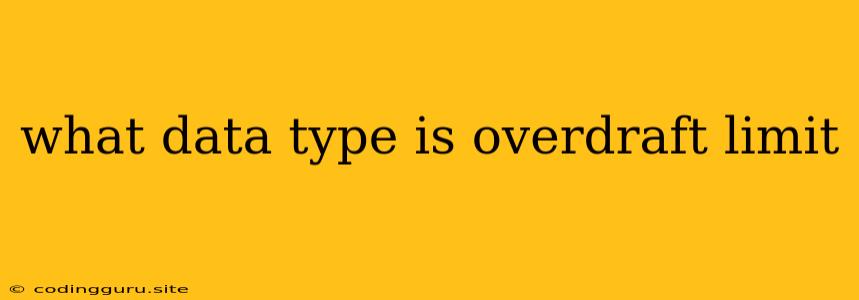Understanding Overdraft Limits and Data Types
Overdraft limits are a common feature in financial institutions, offering a safety net to prevent negative account balances. But what exactly are they, and how are they represented in data?
What is an overdraft limit?
An overdraft limit is the maximum amount of money a bank or credit union will allow you to withdraw or spend beyond your available balance. This limit is set by the financial institution based on factors like your creditworthiness, account history, and income. When you overdraft, you are essentially borrowing money from your financial institution, and interest charges will apply.
Data Types for Overdraft Limits:
Now, let's delve into how overdraft limits are represented in data. It's important to understand that the specific data type used may vary depending on the system and programming language employed. However, some common data types used to represent overdraft limits include:
- Integer: This data type is used to store whole numbers. For example, an overdraft limit of $500 could be represented as the integer 500.
- Decimal or Float: These data types are used to store numbers with decimal places. This is useful for representing overdraft limits that are not whole numbers, such as $450.75.
- Currency: Some programming languages or databases offer specific currency data types. These types often include formatting rules to represent currency symbols and decimal places.
Why is the Data Type Important?
Understanding the data type used for overdraft limits is important for several reasons:
- Accuracy: Choosing the correct data type ensures that overdraft limits are stored and calculated accurately.
- Calculations: Data type affects how calculations are performed, especially when dealing with interest charges or transactions that exceed the limit.
- User Interface: The data type also influences how overdraft limits are displayed to users, ensuring clarity and consistency.
Example:
Let's imagine a banking system using a database to store customer account information, including overdraft limits. The overdraft limit might be stored in a column named "OverdraftLimit" with a data type of "Decimal" or "Float". This would allow for both whole number and fractional overdraft limits.
Tips for Working with Overdraft Limits in Data:
- Use appropriate data types. Choosing the right data type ensures accuracy and avoids potential errors.
- Validate inputs. Check user input to ensure it falls within acceptable limits.
- Implement proper calculations. Develop a clear process for calculating interest charges and handling overdraft transactions.
- Provide clear user interfaces. Make sure users understand how overdraft limits work and how they are displayed.
Conclusion:
Representing overdraft limits accurately in data is crucial for maintaining a secure and reliable financial system. Understanding the different data types available, choosing the appropriate one, and implementing best practices for calculations and validation will ensure the accurate and reliable representation of overdraft limits in your systems.
